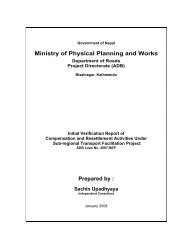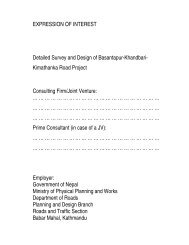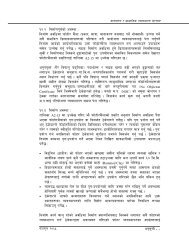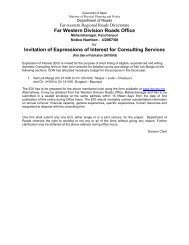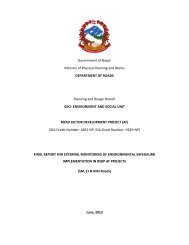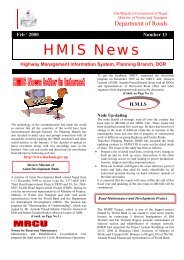Environmental & Social Management Framework - About ...
Environmental & Social Management Framework - About ...
Environmental & Social Management Framework - About ...
Create successful ePaper yourself
Turn your PDF publications into a flip-book with our unique Google optimized e-Paper software.
<strong>Environmental</strong> and <strong>Social</strong> <strong>Management</strong> <strong>Framework</strong>7.2 Comparison of the GoN’s and Donor Agencies Policies on InvoluntaryResettlement and Land Acquisition:Upon request of the Client, this ESMF shall carry out a comparative analysis ofthe national and donor agencies policies on involuntary resettlement/landacquisition, and presents recommendations to bridge identified gaps.7.2.1 Common PrinciplesGenerally, both the donors’ and the policy of GoN support the following basicprinciples:• Involuntary resettlement shall be avoided or minimized to the extent possible,through the incorporation of social consideration into design options andalignment selections.• Where displacement is unavoidable, i.e. people losing assets, livelihood andother resources shall be assisted in improving or at a minimum regaining theirformer status of living at no cost to themselves.There are some areas, however, where additional measures or furtherspecifications for the entitlements under national guidelines and laws arenecessary to meet the standards of the World bank (OP 4.12), ADB (Handbookon resettlement: A Guide to Good Practice) and other agencies. These additionalmeasures are essential for ensuring that the principles mentioned above will beachieved. In addition, a well thought out, specific entitlement framework wouldprotect the project from major delays caused by confusion.7.2.2 Identification of Gaps and Limitations in the National PoliciesThe main gaps and limitations of the national legal and policy framework are:• National law makes provision for compensation to the titled landholder onlyand, by default, omits all other PAP, including non-registered tenant farmers,landless farmers, squatters, agricultural labourers, shopkeepers, artisangroups and Dalits. There are also no provisions to protect the interests ofvulnerable groups.• National law does not make any provision for encroachers or squattersregarding to the entitlement for compensation. The reason to them is to assistpoor people whose assets and livelihoods may be lost or disrupted by theproject.• Accordingly, there is no provision for rehabilitation assistance for suchvulnerable groups.• When GoN requires assets, national law does not specify about the provisionof mandatory replacement cost.• The Land Acquisition Act, 1977 does not emphasize transparency andstakeholder participation for various decisions that directly affect the longtermwellbeing of PAPs. Also, the CDC does not require participation of eitherthe representatives of PAPs or representatives from the localVDC/municipalities.• There are no clear directives to look at project design options that avoid orminimize involuntary resettlement.• Only cash compensation is considered for payment. It is the easiest mode ofoperation but its long- term impact on families who are not used to large cashflow can be more negative than otherwise.• There is a provision in the Land Acquisition Act, 2034 for land-for-landcompensation such that if a titleholder loses all his/her land and opts for landas compensation, the government may provide land if there is ailani(unclaimed land) or other government land available. Past experience,however, indicates that the relevant clauses are too general and do not obligeChapter 7-2 April 2007



![j:6 ]zg cfof ]hgf](https://img.yumpu.com/51286794/1/190x245/j6-zg-cfof-hgf.jpg?quality=85)

![x'nfsL /fhdfu { cfof ]hgf](https://img.yumpu.com/50581959/1/190x245/xnfsl-fhdfu-cfof-hgf.jpg?quality=85)
